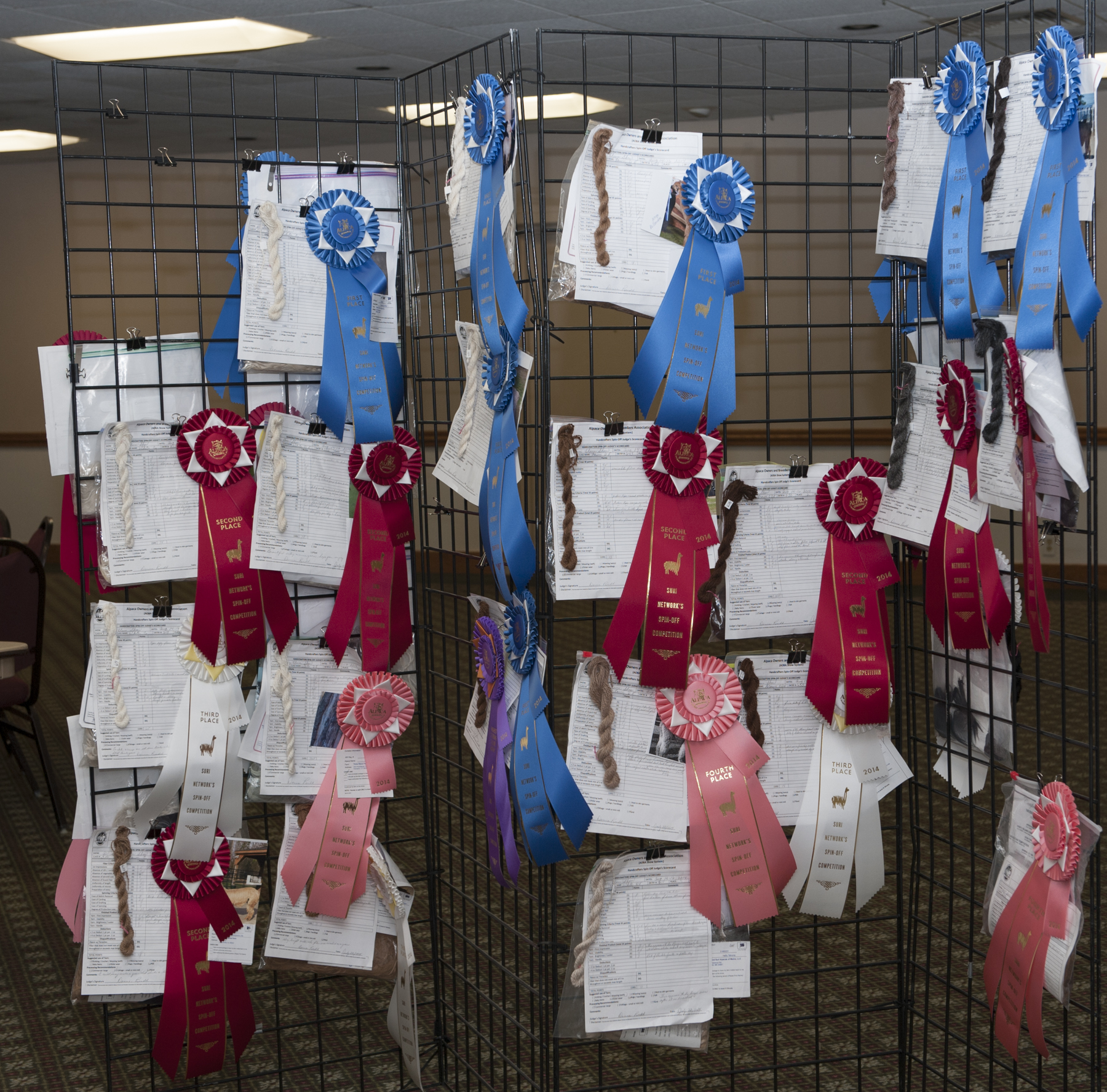The
Suri Symposium and Fleece Show features competition for fleece, cottage fleece, fiber arts and spin-offs. Unique because it is all Suri!!
The 2014 Spin-Off Competition, judged by Certified Master Hand Spinner Donna Rudd, gave entrants an opportunity to present samples of their fleece for spinning. We asked Donna for her perspective concerning Spin-Offs and here is what she told us.
What can one learn by entering a Spin-Off?
The evaluation given by a spin-off judge provides a broad range of evaluations based on first impression of the raw fiber sample to evaluating it for flaws such as excessive guard hairs, tenderness and second cuts and finally the finished hand spun yarn.
Records are kept of the time and effort spent on removing debris, carding, drafting and spinning the fiber and points are appointed accordingly. It is important to know that any debris or vegetable matter will affect each and every step of this process and ultimately your finished yarn and product. Points awarded for degree of loss are also important to note because this directly affects a producers financial affairs in the big picture.

When a Spin-Off judge evaluates the finished yarn they are not evaluating their spinning proficiency. Rather, they are looking at how the fiber behaved to being manipulated into the twisted state. If there was vegetable matter, snags and snarls from second cuts or tender fibers or uneven lengths of fibers and a large variation of microns there will be a huge discrepancy in the yarn grist and twist. The yarn is evaluated for its durability, versatility and overall desirability, finally for handle, visual appeal and handle.
It is the points awarded and the faults noted that really tell the full story of the fiber. For example, if there were very low marks for absence of guard hair and degree of production loss, this would tell me that your yarn is likely to appear and feel hairy and that a lot of the finer fibers were lost or broken during fiber preparation. The resulting yarn is likely to be very unevenly spun giving low marks for ‘Yarn first impression and hand’. Whereas, if you had an entry which was uniform in length, micron with few faults such as vegetable matter and guard hairs, it is likely to have high marks in fiber preparation and certainly high points for a superior yarn.

It is the points noted above that assist you in understanding the whole story of your raw fiber. Judges even go so far as to suggest end uses for your fiber and make personal comments which are intended to encourage you in your fiber production.
Where else can you learn so much for so little?
Is it hard to prepare a sample for a Spin-Off?
No, it’s as easy as 123!
- Always read the show rules to know exactly how many ounces to submit, entry deadline, cost and address. Most AOA shows have a limit of 2-4 ounces. Weigh your entry after you have prepared it and removed vegetable matter & debris.
- Choose a good clean mid-side sample from your fleece, remove coarse locks, excess debris, second cuts and vegetable matter without disturbing the lock structure too much, and give it a good shake to remove dust and sand.
- Review your entry to ensure it is as clean, uniform and consistent in length and micron as possible. Fill out your entry forms, attach your payment and pop them in the mail!
What do you look for in a Spin-Off entry?
Cleanliness, luster, uniformity of locks in every way (length, micron, style) and lack of faults that could lead to lost points for an otherwise perfect entry! Many times I find an entry that makes my heart leap for joy as I open the package; its lustrous beautiful locks appear perfect. Then, I find faults, such as tender fibers, matting, second cuts or excessive debris deep within the beautiful locks which of course has a large amount of broken fibers with it…hence, huge fiber loss. That beautiful entry that just got high marks for first impressions got very low marks for fiber preparations and again low marks for the resulting yarns and it did not win the race!
The entry that is clean and has uniform lengths and microns and bright luster will generally receive the highest points all across the score card and result in the most consistent yarn.
Are there any special tips that you, a Master Spinner and judge, have for people interested in entering Spin-Offs?
Spin-Off score cards are a valuable tool in your tool box! They give you a totally unique look at your fiber from an impartial hand spinner’s point of view. Learn from it, question it, and run with it.
The score card can give you a realistic impression of the fiber and production loss on your fleece so that you can take that into consideration for planning commercial processing.
Plus, the score card can be a marketing tool! If you have a winning score card, a champion, it can aid you in selling your fleece, your fiber, your yarn. It can assist you selling your genetics and your breeding program to others.
- Take the time to evaluate your entry as you prepare it for the show.
- Double check for coarse locks and second cuts that may have been overlooked when you prepared the fiber.
- Double check your entry weight just before you seal the bag.
The Suri Network Board of Trustees appreciates the expertise of Donna Rudd as our 2014 Spin-Off and Fiber Arts judge. We hope that Donna's insights encourage all our members to enter the all-Suri Spin-Off competition in 2015!